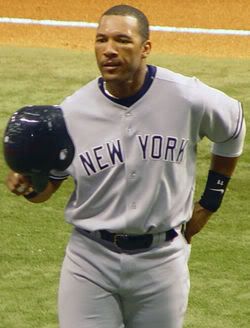Indians  Indians Archive
Indians Archive  Tigers Becoming Win Now Addicts
Tigers Becoming Win Now Addicts
 Indians Archive
Indians Archive  Tigers Becoming Win Now Addicts
Tigers Becoming Win Now Addicts
Written by
Erik Cassano
 The best division in baseball got a little better a couple of days ago when the defending American League champion Tigers went out and acquired slugger Gary Sheffield from the Yankees for three minor league pitchers. On paper, this cements Detroit as the favorite to once again represent the AL in the World Series. But Papa Cass can't help but wonder if they aren't making some of the same mistakes that the Indians did at the conclusion of the John Hart era.
The best division in baseball got a little better a couple of days ago when the defending American League champion Tigers went out and acquired slugger Gary Sheffield from the Yankees for three minor league pitchers. On paper, this cements Detroit as the favorite to once again represent the AL in the World Series. But Papa Cass can't help but wonder if they aren't making some of the same mistakes that the Indians did at the conclusion of the John Hart era.
 Visit the Papa Cass weblog at http://papacass.blogspot.com/
Visit the Papa Cass weblog at http://papacass.blogspot.com/
Let's size up the good of the Tigers' acquisition of Gary Sheffield first:
He brings raw power and bat speed that is almost unmatched among right-handed hitters, Alex Rodriguez, Albert Pujols and Manny Ramirez being among the few in his class.
He'll make Detroit's lineup even more fearsome combined with a healthy Magglio Ordonez and Sean Casey. The Tigers will not hurt for RBIs next year.
He is reunited with manager Jim Leyland. Together in 1997, they won the only World Series either of them has ever won.
All fine and good. The Tigers, deservedly so, will be the favorites to win the AL pennant, and maybe the World Series, come February.
But the acquisition of Sheffield should also send up an early warning flare for Tiger fans.
Take it from an Indians fan who has watched this all happen before: when a team gets a taste of winning, especially when it reaches the World Series and loses, the temptation is there for management to start spending and trading to get a title.
Trading three minor-league pitching prospects for a 37-year-old, injury-prone DH could get the Tigers over the hump. Or it could be an iceberg on the horizon.
It is far too easy for a team flush with success to bloat its payroll and empty out its farm system in a quest to win it all. It's a quest that, in many ways, a team cannot totally control.
Consider the cautionary tale of the Indians:
From 1991 to 1995, former Indians GM John Hart was among the best in baseball. He made shrewd trades and signings that made the Indians competitive, held the young core of star players intact and kept the payroll reasonable.
Then came 1995, and the Tribe's first pennant in 41 years. The Indians came oh-so-close to a championship and didn't get it.
Somewhere between the '95 and '96 seasons, Hart abandoned his farm-system centered philosophy and began trying to spend his problems away. Shrewd moves like plucking Kenny Lofton from the Astros for Eddie Taubensee and Willie Blair were replaced with short-term moves that decimated the farm system and left the Indians with overpaid, underproductive players.
Jeromy Burnitz for Kevin Seitzer. Brian Giles for Ricardo Rincon. Danny Graves for John Smiley. Sean Casey for Dave Burba.
Over the span of about three years, Hart transformed the Indians from a nimble organization with a stocked farm system to an aging organization with a depleted farm system and bloated payroll.
It sustained the Indians' run of division titles, but it was a method doomed to fail in the end. By 2001, new GM Mark Shapiro was learning that a complete teardown and rebuild was the only way to save the organization as it stood.
Tiger fans can rightfully take pride in a team full of promising young players. But that young roster can be scattered to the four corners of the country so easily if a front office doesn't learn the lessons of those who came before.
To say "That's Cleveland, we'll do it differently" is the height of arrogance. It can happen to you, and if Tigers management keeps making trades like this, it will happen.
 Visit the Papa Cass weblog at http://papacass.blogspot.com/
Visit the Papa Cass weblog at http://papacass.blogspot.com/ Let's size up the good of the Tigers' acquisition of Gary Sheffield first:
He brings raw power and bat speed that is almost unmatched among right-handed hitters, Alex Rodriguez, Albert Pujols and Manny Ramirez being among the few in his class.
He'll make Detroit's lineup even more fearsome combined with a healthy Magglio Ordonez and Sean Casey. The Tigers will not hurt for RBIs next year.
He is reunited with manager Jim Leyland. Together in 1997, they won the only World Series either of them has ever won.
All fine and good. The Tigers, deservedly so, will be the favorites to win the AL pennant, and maybe the World Series, come February.
But the acquisition of Sheffield should also send up an early warning flare for Tiger fans.
Take it from an Indians fan who has watched this all happen before: when a team gets a taste of winning, especially when it reaches the World Series and loses, the temptation is there for management to start spending and trading to get a title.
Trading three minor-league pitching prospects for a 37-year-old, injury-prone DH could get the Tigers over the hump. Or it could be an iceberg on the horizon.
It is far too easy for a team flush with success to bloat its payroll and empty out its farm system in a quest to win it all. It's a quest that, in many ways, a team cannot totally control.
Consider the cautionary tale of the Indians:
From 1991 to 1995, former Indians GM John Hart was among the best in baseball. He made shrewd trades and signings that made the Indians competitive, held the young core of star players intact and kept the payroll reasonable.
Then came 1995, and the Tribe's first pennant in 41 years. The Indians came oh-so-close to a championship and didn't get it.
Somewhere between the '95 and '96 seasons, Hart abandoned his farm-system centered philosophy and began trying to spend his problems away. Shrewd moves like plucking Kenny Lofton from the Astros for Eddie Taubensee and Willie Blair were replaced with short-term moves that decimated the farm system and left the Indians with overpaid, underproductive players.
Jeromy Burnitz for Kevin Seitzer. Brian Giles for Ricardo Rincon. Danny Graves for John Smiley. Sean Casey for Dave Burba.
Over the span of about three years, Hart transformed the Indians from a nimble organization with a stocked farm system to an aging organization with a depleted farm system and bloated payroll.
It sustained the Indians' run of division titles, but it was a method doomed to fail in the end. By 2001, new GM Mark Shapiro was learning that a complete teardown and rebuild was the only way to save the organization as it stood.
Tiger fans can rightfully take pride in a team full of promising young players. But that young roster can be scattered to the four corners of the country so easily if a front office doesn't learn the lessons of those who came before.
To say "That's Cleveland, we'll do it differently" is the height of arrogance. It can happen to you, and if Tigers management keeps making trades like this, it will happen.
Posted by
Erik Cassano
Nov 11, 2006 7:00 PM
- NBA Announces 2013-2014 Schedule
- Browns Ink Sharknado
- Sharknado A No-Show For Rookie Camp
- Trent Richardson Out Until Training Camp
- Browns Sign Brandon Jackson
- Carrasco Suspended Eight Games
- Browns Add to Wide Receiver Depth with David Nelson
- Browns Need to Learn from Past Draft Mistakes
- Browns Release Chris Gocong and Usama Young
- Browns Missing on Grimes Disappointing, But Not The End
The TCF Forums
- Official- Browns Coach Search/Rumors
Larvell Blanks (Tuesday, January 21 2014 11:53 AM) - The 2014 Offseason Thread
skatingtripods (Tuesday, January 21 2014 11:52 AM) - Chris Grant's first 3 drafts
Kingpin74 (Tuesday, January 21 2014 10:13 AM) - 2015 Recruiting
furls (Tuesday, January 21 2014 6:57 AM) - Mike Brown
YahooFanChicago (Monday, January 20 2014 11:15 PM) - Movies coming out
HoodooMan (Monday, January 20 2014 9:34 PM) - 2014 Hoops Hockey Hijinx
jpd1224 (Monday, January 20 2014 4:44 PM) - 2014 Recruiting
jclvd_23 (Monday, January 20 2014 2:26 PM) - Wish List - #4 Pick
Hikohadon (Monday, January 20 2014 1:26 PM) - #1 overall pick Anthony Bennett
TouchEmAllTime (Sunday, January 19 2014 1:28 PM)



